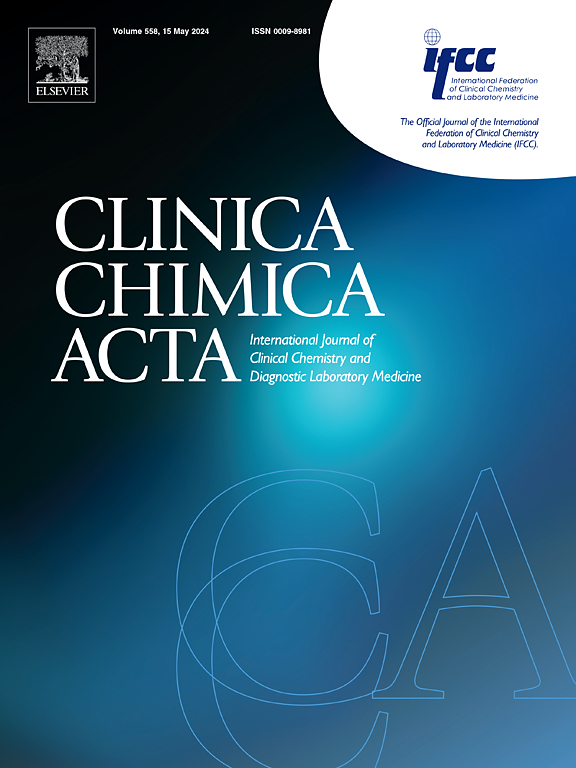Quality control frequency: Unleashing the truth
IF 3.2
3区 医学
Q2 MEDICAL LABORATORY TECHNOLOGY
引用次数: 0
Abstract
Objectives
This study investigates the optimal number of quality control (QC) events per day in two scenarios: high-sensitive troponin, requiring three levels of QC materials, and creatinine, with two levels. The aim is to explore how different QC rules and sigma metric values affect the frequency of QC events, considering both analytical performance and the clinical impact of potential measurement errors as severity of harm.
Methods
Risk-based QC calculations were performed using the QC Constellation tool. Four QC rule schemes (1–3 s, 1–3 s/2–2 s, 1–3 s/2–2 s/R-4 s, 1–3 s/2–2 s/R-4 s/4–1 s) were tested for high-sensitive troponin (catastrophic harm) and creatinine (serious harm). Sigma metric values from 3 to 6 were evaluated to determine maximum run sizes. QC event frequency was estimated for a hypothetical laboratory processing 1,000 samples daily.
Results
Maximum run sizes decreased as sigma metric values declined. Correspondingly, the number of QC events per day increased as sigma metric values decreased. For high-sensitive troponin, with its catastrophic severity of harm related to potantial error, more frequent QC was necessary compared to creatinine.
Conclusions
Analytical performance and severity of harm significantly influence the required frequency of QC events. Laboratories must consider both factors when designing QC strategies to balance patient safety with operational efficiency. For analytes with high severity of harm, achieving higher sigma metrics is critical to maintain feasible and cost-effective QC practices. A hybrid QC approach combining risk-based and patient-based methods may optimize QC strategies, but standardization of sigma metric calculations is still needed.
质控频率:释放真相。
目的:本研究探讨两种情况下每天质量控制(QC)事件的最佳数量:高敏感肌钙蛋白,需要三个水平的QC材料,和肌酐,需要两个水平。目的是探讨不同的QC规则和sigma度量值如何影响QC事件的频率,同时考虑分析性能和潜在测量误差的临床影响作为危害的严重程度。方法:采用QC Constellation工具进行基于风险的QC计算。四个QC规则方案(1 - 3 年代,1 - 3 s / 2 - 2 年代,1 - 3 s / 2 - 2 s / R-4 年代,1 - 3 s / 2 - 2 s / R-4 s / 4 - 1 s)是进行高灵敏度检测肌钙蛋白(灾难性的伤害)和肌酸酐(严重损害)。评估3至6的Sigma度量值以确定最大运行规模。假设实验室每天处理1,000个样品,估计QC事件频率。结果:最大运行尺寸随着西格玛度量值的下降而减小。相应地,随着西格玛度量值的降低,每天QC事件的数量增加。对于高敏感的肌钙蛋白,由于其灾难性的严重程度与潜在的错误有关,与肌酐相比,更频繁的QC是必要的。结论:分析效能和危害严重程度显著影响QC事件所需频率。实验室在设计质量控制策略以平衡患者安全和操作效率时必须考虑这两个因素。对于危害严重的分析物,实现更高的西格玛指标对于维持可行和具有成本效益的QC实践至关重要。结合基于风险和基于患者的方法的混合质量控制方法可以优化质量控制策略,但仍然需要sigma度量计算的标准化。
本文章由计算机程序翻译,如有差异,请以英文原文为准。
求助全文
约1分钟内获得全文
求助全文
来源期刊

Clinica Chimica Acta
医学-医学实验技术
CiteScore
10.10
自引率
2.00%
发文量
1268
审稿时长
23 days
期刊介绍:
The Official Journal of the International Federation of Clinical Chemistry and Laboratory Medicine (IFCC)
Clinica Chimica Acta is a high-quality journal which publishes original Research Communications in the field of clinical chemistry and laboratory medicine, defined as the diagnostic application of chemistry, biochemistry, immunochemistry, biochemical aspects of hematology, toxicology, and molecular biology to the study of human disease in body fluids and cells.
The objective of the journal is to publish novel information leading to a better understanding of biological mechanisms of human diseases, their prevention, diagnosis, and patient management. Reports of an applied clinical character are also welcome. Papers concerned with normal metabolic processes or with constituents of normal cells or body fluids, such as reports of experimental or clinical studies in animals, are only considered when they are clearly and directly relevant to human disease. Evaluation of commercial products have a low priority for publication, unless they are novel or represent a technological breakthrough. Studies dealing with effects of drugs and natural products and studies dealing with the redox status in various diseases are not within the journal''s scope. Development and evaluation of novel analytical methodologies where applicable to diagnostic clinical chemistry and laboratory medicine, including point-of-care testing, and topics on laboratory management and informatics will also be considered. Studies focused on emerging diagnostic technologies and (big) data analysis procedures including digitalization, mobile Health, and artificial Intelligence applied to Laboratory Medicine are also of interest.
 求助内容:
求助内容: 应助结果提醒方式:
应助结果提醒方式:


